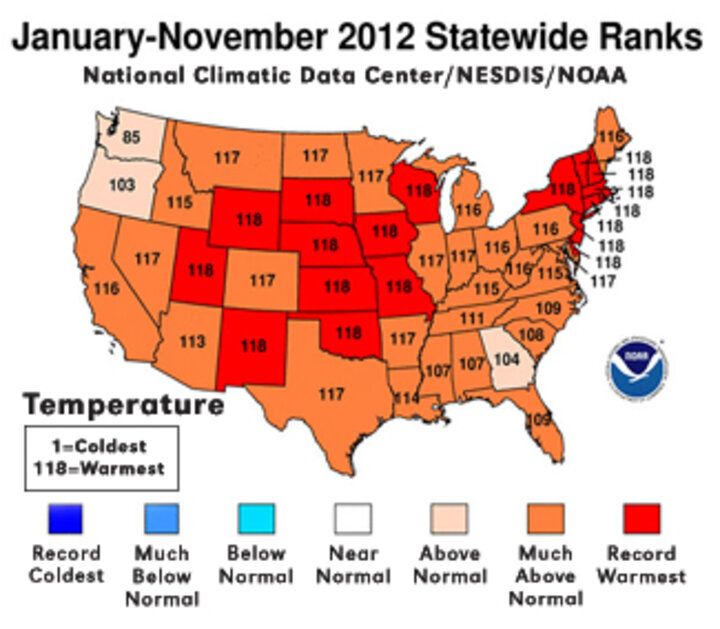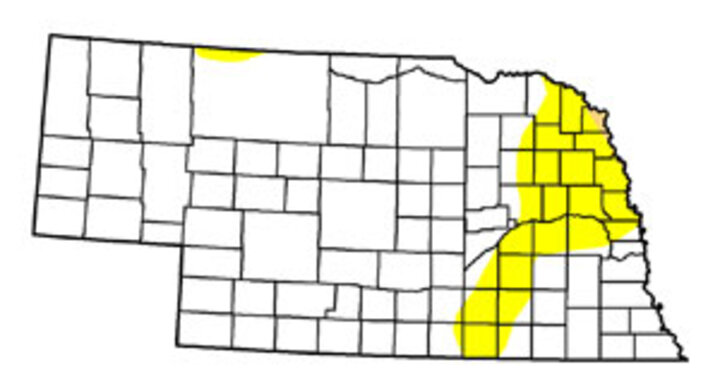

December 20, 2012
How the Drought Evolved in 2012
Maps courtesy of the National Drought Mitigation Center


January 3, 2012

March 6, 2012

May 8, 2012

June 6, 2012

July 24, 2012

August 14, 2012

September 4, 2012

December 11, 2012
Nebraska has been at the epicenter of the U.S. drought since September, affecting agricultural production, water supplies, wildfires, and wildlife. These impacts will only intensify if drought lasts through the winter, as is forecast, say climatologists at the National Drought Mitigation Center at the University of Nebraska-Lincoln.
"The previous five years all had above-normal precipitation, the wettest period in recorded history," said Michael Hayes, the center's director. "For Nebraska, it was unprecedented. We came into 2012 with a full hydrological system – rivers, streams, reservoirs and groundwater. When you're talking major droughts, this is not a multi-year drought. As we look ahead to 2013, we don't have that margin built into our hydrological system, so we're in pretty dire straits."
Nebraska, Colorado, and Wyoming are on track to record their driest year on record in 2012, Hayes said, and the country is having its hottest year on record. Texas, Oklahoma and New Mexico are in their second year of drought, while the eastern edge of the Corn Belt is seeing some relief. In the lower 48 states more than 60% of the land area is experiencing moderate to exceptional drought. (See DroughtMonitor.unl.edu.)
The National Weather Service's Climate Prediction Center reports that the drought in the Plains is likely to continue at least through February.
"Right now the expectations are for increased odds of above-normal temperatures across quite a bit of the nation," Hayes said. The prediction for winter moisture is less clear, Hayes said, with a potential for Nebraska seeing both dry and wet weather this winter.
Even with some moisture, UNL State Climatologist Al Dutcher said he sees only a 10-20% likelihood of Nebraska getting a winter wet enough to bring moisture levels back to normal.
Recovery Will Take Time
"In Nebraska and the central Plains, we've started seeing the drought feeding off itself, with the dry soils and dry air not allowing precipitation events to develop as usual," said Brian Fuchs, climatologist at the National Drought Mitigation Center. "With the lack of moisture, we're more like a desert environment. It warms up fairly quickly during the day, but drops quickly at night."
"When we do have precipitation, very little will go to runoff," Fuchs said. "Those soils are going to act as a big sponge. They're just going to take in a lot of the moisture. We'll continue to see problems of stock ponds, smaller lakes, and streams dropping. The hydrologic drought hasn't reared its head, but it's there, as we are seeing more water systems under stress." {Highlight what hydrologic drought means}
"Typically when farmers are done irrigating, you will see the water in the Platte percolate back through the basin," Fuchs said. "We did see that response, but it was very minimal and that was even with the irrigation season ending sooner than usual. The channels are tiny, with these very small threads of water in eastern Nebraska."
Agricultural Losses
Nationwide, as of December 10, $8 billion in agricultural indemnity payments had been paid, according to USDA's Risk Management Agency. In 2012 80% of the eligible acres nationwide and 90% to 95% of those in Nebraska had crop insurance, said Rebecca Davis, RMA director for the region including Colorado, Kansas, Missouri, and Nebraska.
She said nationwide Nebraska is the fourth largest consumer of crop insurance and the fifth largest recipient of indemnity payments. As of November 19 nearly $483 million had been paid out in Nebraska, with corn alone accounting for $363.2 million of the covered loss. By November 26, total Nebraska indemnities were at $544 million, with $502 million due to drought, heat, and dry wind on more than two million acres of cropland.
By the end of 2012 hay prices had climbed to $200 a ton in Nebraska, more than double the previous record, according to the Nebraska office of the USDA National Agricultural Statistics Service. That increase was, in part, due to a major drought in 2011 in the South Plains.
"Nebraskans sent a lot of their hay supplies south in 2011," Hayes said. "Little did they know there would be a drought here in 2012. That's going to have a large impact on ranchers as we go forward."
Water Supplies — Natural and Public
Resource managers in Nebraska are also keeping an eye on the Republican River Basin to see whether it will be a water-short year. This could affect water use agreements with Colorado and Kansas, Fuchs said. Managers also are watching the water level in Lake McConaughy, which is about 60% of normal for this time of year and 25% lower than this time last year. Recovery will depend on snowpack upstream in the Rocky Mountains.
"So far we've had a bad start to the snow season in the Central Rockies," Fuchs said. Anecdotal evidence suggests that in some areas, groundwater levels are declining.
"I would see that exponentially increasing if we stay dry in 2013," Hayes said.
Fuchs recommended that wells be checked for reliability this winter, before hot weather and the growing season increase water use.
Catastrophic Fire Year
Nebraska had its worst fire season since 1919, with central and western Nebraska being hit hardest. Don Westover, fire program leader of the Nebraska Forest Service, reported that as of Dec. 14, the state had 1,426 wildfires reported, burning more than 400,752 acres and 65 structures for an estimated loss of $12 million so far. Final reports on several large wildfires have still not been filed and would add another 94,000 acres to the total.
Scott Josiah, director of the Nebraska Forest Service, described this year's fire activity as catastrophic, with off-the-charts fire intensity and behavior. This type of fire can cause long-term changes in land cover and damage watersheds by
- removing vegetation and soil litter,
- depositing ash,
- accelerating runoff, flooding, erosion, and downstream sedimentation, and
- impairing water quality and fisheries habitat.
Even in the absence of fire, drought is taking a toll on trees.
"Many of the scorched Ponderosa Pine trees would normally survive if they get some precipitation, but given the continuing drought, I think we'll lose a lot more trees from the combination of drought and fire and then more drought," Josiah said. "I was in the Niobrara Valley last week and noted fairly frequent tree mortality even in the unburned pine forests, presumably due to drought."
Toll on Wildlife
Drought and resource management decisions are affecting wildlife as well. The Nebraska Game and Parks Commission said the state's deer population is undergoing the worst outbreak of epizootic hemorrhagic disease since the 1970s, fueled by the drought. In addition, emergency haying of conservation reserve program lands has reduced cover for upland game birds such as pheasants and quail.
Drought Resources
For more information on the drought:
-
DroughtResources.unl.edu — UNL Extension website with drought information for the farm, ranch, and home
- National Drought Mitigation Center
Kelly Helm Smith
Communication and Drought Resources Specialist
National Drought Mitigation Center
